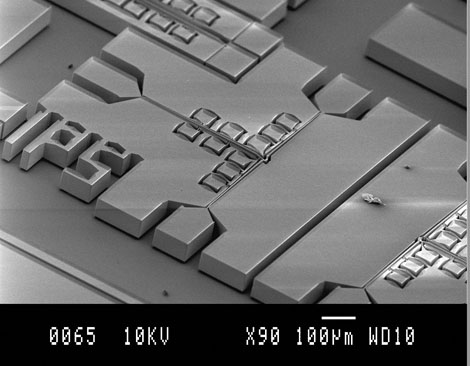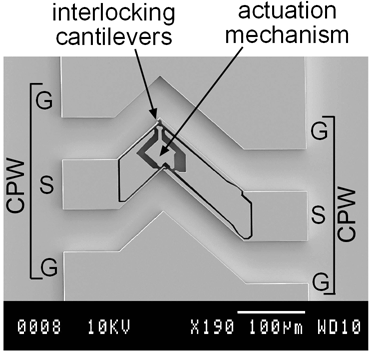Novel concepts for RF MEMS switches
Unconventional, novel RF MEMS switch concepts developed at KTH-EE-MST since 2002, addressing major obstacles in RF MEMS switch development
Already in 1991, the first RF MEMS switch was presented (Larson, HRL). Even though the technology was immature at that time, that device had exceptionally good electric signal properties. Switch development has matured in the end of the 1990s, and in 2000-2005 the main focus in switch research was reliability.
At KTH-EE-MST, unconventional transmission-line based switch designs have been researched on, including
- low voltage, large displacement switches
- large scale switch arrays integrated on a single chip, for reconfigurable telecommunication networks
- interlocking, mechanically multistable switches with static zero power consumption
- coplanar transmission-line integrated mechanically multistable switches microwave switches, for low-loss, static zero power consumption reconfigurable RF systems
Besides transmission-line based micro-electromechanical switches, recent research includes waveguide based switches which are directly switching the electromagnetic wave propagation in waveguide.

Large displacement switch for high-isolation. A double zipper actuator is used, which allows the switch to be actuated at only 12V, despite a switching contact displacement of 14µm. Drawback of the concept is larger size than conventional switches.

Large-scale switch array for reconfigurable telecommunication networks. This single chip, of a total size of 10x14 mm2, contains 800 switches, which can be actuated as 400 independent switch pairs. Collaboration project with Network Automation AB, and Silex Microsystems.

Laterally moving, mechanically multi-stable cantilever switches
with large, active opening forces. The first generation prototypes were fabricated in a collaboration project with Nanyang Technological University, Singapore, School of Electrical and Electronics Engineering, Photonis Lab II. These switches feature active opening with very large opening forces, and a passive closing force, making the mechanism very suitable for soft contact materials. Furthermore, the cantilever tips are endowed with interlocking hooks, i.e. the switches are mechanically stable in the on-state and in the off-states, which means that no external energy/voltage is needed to maintain the switch states.

Micromachined 3D-transmission line embedded, mechanically multistable single-pole-single-throw (SPST) and single-pole-double-throw (SPDT) switches with very low intrusive RF design (low reflections, low insertion loss), since the complete switch mechanism is fully embedded in the signal line of a coplanar waveguide. The switches are mechanically multistable, feature active opening, and are fabricated in a single photolithography mask process.

Close-up view of the interlocking mechanism of two cantilevers forming a switch element. The hooks on the tips of the cantilevers allow for mechanical locking the switch in the on-position, and can be unlocked for the off-position. In both states, no external energy is needed to maintain the switch in the respective position. External energy is only needed for the transition between the two states.
People involved:
Mikael Sterner
Stefan Braun (alumni)
Project leader:
Joachim Oberhammer
The first prototypes of the interlocking cantilever switches have been developed in collaboration with NTU Singapore (Prof. Liu Ai-Qun) and with IME Singapore (Dr. Tang Min).
